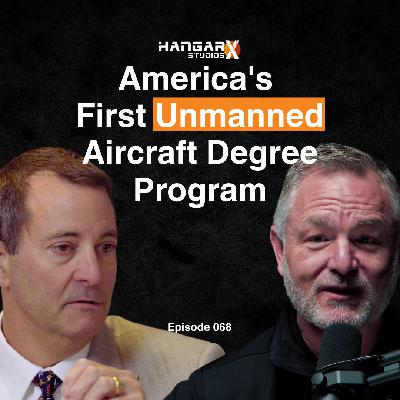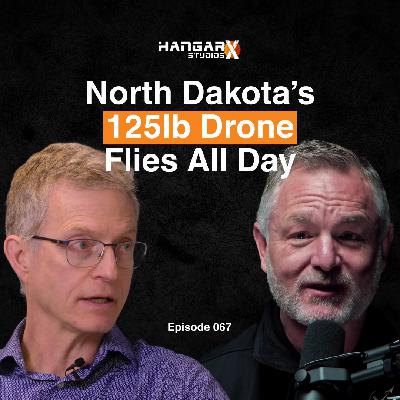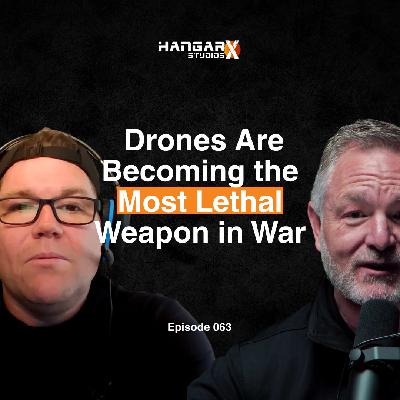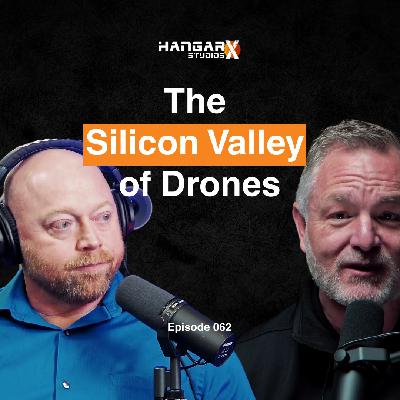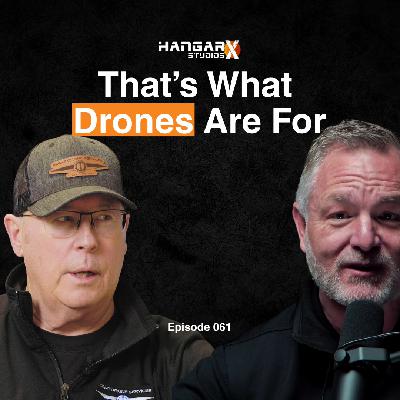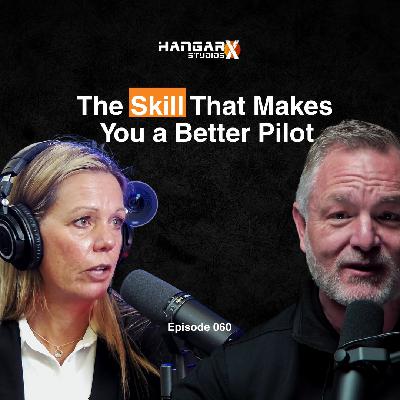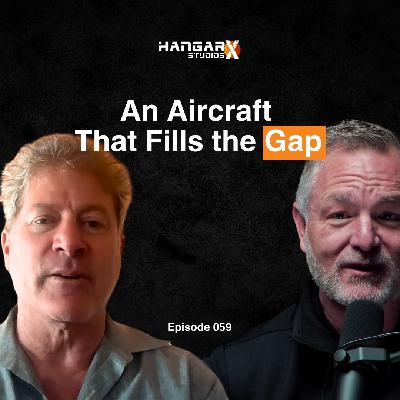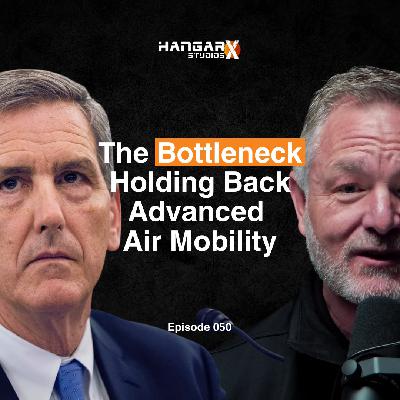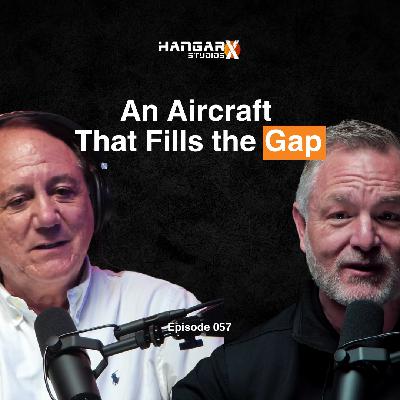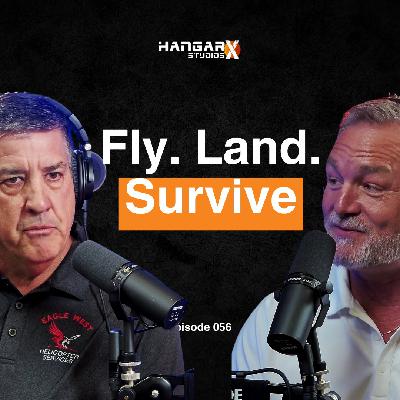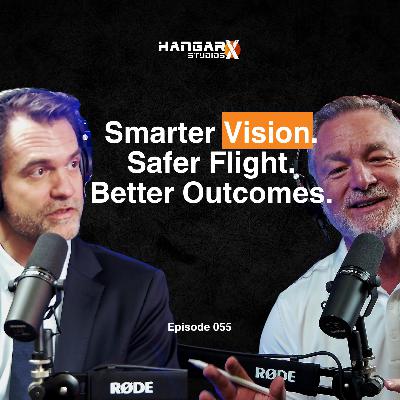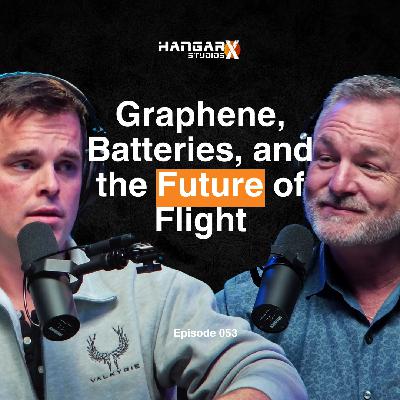Discover Hangar X Studios
Hangar X Studios

Hangar X Studios
Author: John Ramstead
Subscribed: 1Played: 3Subscribe
Share
© 2025
Description
Hangar X Studios is all about innovation in the aerospace industry. The show is a joint venture between Innovation4Alpha and XTI Aerospace. Episodes will feature pilots, aviation leaders, business aviation experts, engineers and more.
71 Episodes
Reverse
Former Army helicopter pilot and FAA leader James “Jim” Viola, now President and CEO of the General Aviation Manufacturers Association (GAMA), joins host John Ramstead to map where aerospace manufacturing and operations are headed next. From composites and 3D printing to data-driven certification, AI, and hybrid-electric propulsion, Jim explains how innovation can move faster while staying safe. He opens up on supply chain bottlenecks, why condition-based maintenance must replace calendar-based overhauls, what it will take to make AAM and eVTOL commercially viable, and why ATC modernization is the critical path to scale. If you care about building, certifying, or flying the future of aviation, this is your playbook.
Episode Highlights
How GAMA aligns manufacturers, regulators, and operators to get safe technology to market faster
Advanced manufacturing in practice: composites, additive, digital threads, and real-time quality data
AI’s role in predictive maintenance, automation, and the human-in-the-loop question
Certification reality checks and how to keep programs moving with measurable milestones
AAM and eVTOL operations: why IFR capability and procedures are essential to scale
ATC modernization and the Modern Skies initiative as the backbone for the next decade
Hybrid-electric propulsion, multi-path redundancy, and the path to safer operations
Practical vision for rooftops, vertiports, and using existing community infrastructure
Unleaded avgas transition timelines and what it means for the fleet
Key Points with Timestamps
00:00:00 Safety by design: if cars auto brake, why can aircraft still collide
00:00:28 Show open, sponsor XTI Aerospace, and guest intro
00:03:35 GAMA’s mission: accelerate innovation and certification while protecting safety
00:06:11 The full manufacturing ecosystem: aircraft, engines, avionics, MRO, training
00:06:45 Composites and 3D printing meet the regulator’s education curve
00:08:24 Industry 4.0 in aerospace manufacturing
00:08:47 Re...
Propellers may not be the “sexy” part of an aircraft, but the team at Athule Aero is proving they’re the key to unlocking the future of advanced air mobility. In this episode of Hangar X Studios, host John Ramstead sits down with Tony Bacarella, CEO of Athule, to explore how their patented “Double Break” propeller technology is cutting noise by up to 75% and improving efficiency by up to 15%. From custom AI-designed blades for drones to game-changing applications in manned VTOLs, general aviation and even naval uses, Tony explains why the humble propeller is the next big catalyst for aerospace innovation.
️ Episode Highlights
How Athule’s “Double Break” design reshapes the tip of a propeller to slash noise and redistribute thrust
AI/ML-powered design tools that create custom propellers in days, not months
Why noise reduction is critical for urban air mobility adoption
The growing market for U.S.-made drone and propeller components
Opportunities in manned VTOL, hybrid-electric regional aircraft and beyond
⏱️ Key Points with Timestamps
[00:00:00] Welcome to Hangar X Studios & John’s introduction of the vertical economy
[00:01:00] Why propellers are the overlooked “missing link” in EVTOL and drone adoption
[00:02:29] Meet Tony Bacarella – Athule’s breakthrough in propeller technology
[00:04:01] Why propellers are usually an afterthought & how Athule customizes them
[00:04:49] The “aha moment”: validating the tech through an Air Force/AFWERX program
[00:05:52] Explaining Athule’s patented “Double Break” blade and how it deloads the tip
[00:08:36] AI/ML tool redistributes thrust and shapes noise profiles for each aircraft
[00:10:20] Majority of Athule’s work is custom; mass-production also possible
[00:11:17] Noise, FAA rules, and community acceptance for vertiports and urban c...
In this episode of Hangar X Studios, host John Ramstead sits down with Dana Sande, President of the UND Aerospace Foundation, to explore how the University of North Dakota became a global leader in aviation and unmanned aircraft systems (UAS) education. From pioneering the first unmanned aircraft pilot degree program in the U.S. to building cutting-edge facilities like Gorman Field, the conversation dives into UND’s influence on commercial aviation, UAS innovation, and partnerships with both private industry and the military.
Listeners will gain insight into how UND’s Aerospace Foundation helps the university “operate at the speed of business,” supporting rapid prototyping, pilot training, and drone testing—all while keeping education affordable for future aviation leaders.
If you’ve ever wondered how UND shaped the future of unmanned aviation and why Grand Forks has become a hub for aerospace innovation, this episode is packed with answers.
Episode Highlights
How UND pioneered unmanned aircraft pilot training in the U.S.
The UND Aerospace Foundation’s unique role in bridging education with industry.
Stories of partnerships with Cirrus, Cessna, and XTI Aerospace.
Inside Gorman Field – UND’s state-of-the-art facility for UAS training and testing.
Why UND grads are flying more MQ-9 Predators than anyone outside the U.S. military.
The growing importance of counter-drone technology and defense innovation.
Key Points with Timestamps
[00:00:00] Dana Sande introduces UND’s leadership in unmanned aircraft pilot training—the first degree program of its kind in the U.S.
[00:02:16] UND trains across all aviation sectors: pilot training, air traffic control, engineering, atmospheric sciences, and airport management.
[00:03:35] Origins of the UND Aerospace Foundation (1985) and its mission to help UND operate at the speed of business.
[00:04:34] Partnership examples: factory training for Cirrus, managing Cessna’s eLearning, FAA-mandated training courses.
In this episode of Hangar X Studios, host John Ramstead sits down with John Ibele, co-founder of Meadowlark Aircraft Manufacturing, to explore the future of American-made drones. With decades of experience in high-volume manufacturing at Seagate, Ibele shares how lessons from producing millions of disk drive components in Asia can be applied to building drones right here in the U.S. The conversation spans topics like design for manufacturing (DFM), the advantages of domestic production, the challenges of scaling drone manufacturing, and the ambitious vision behind Meadowlark’s flagship fixed-wing VTOL drone, the FH125 “Strix.”
This episode is a fascinating look at how North Dakota is emerging as a hub for aerospace innovation, and how entrepreneurs like Ibele are determined to strengthen America’s manufacturing resilience in the drone industry.
Episode Highlights
Why much of America’s high-volume manufacturing shifted overseas—and how to bring it back.
Meadowlark Aircraft Manufacturing’s origin story and bold vision.
Insights into design for manufacturing (DFM) and how it drives product and process decisions.
The FH125 “Strix”: a fixed-wing VTOL designed for precision agriculture, wildlife management, fire and rescue, and perimeter security.
Managing massive data collection from drones with edge computing and transmission strategies.
Why North Dakota is the right place to launch a drone manufacturing company.
Key Points with Timestamps
[00:00:00] John Ibele on U.S. manufacturing: too often high-volume production defaults overseas, but domestic advantages are being rediscovered.
[00:00:58] Host John Ramstead introduces the sponsor (XTI Aerospace) and welcomes listeners to the live recording at The Hive, Grand Forks.
[00:02:42] Ibele shares how his partnership with Ned Tabet and background at Seagate led to founding Meadowlark.
[00:03:50] Introduction of the FH125 “Strix”—a fixed-wing VTOL drone with a 16-foot wingspan designed for all-day endurance.
India may be the world’s seventh-largest country with the largest population, but when it comes to helicopters, the numbers tell a surprising story—just 270 helicopters serve over 1.4 billion people. In this episode of Hangar X, host John Ramstead sits down with Air Marshal (Retd.) Anil Butola, President of the Rotary Wing Society of India (RWSI) and former Indian Air Force test pilot, to unpack the state of India’s helicopter and vertical lift industry.
From his 42-year career in the Indian Air Force to leading efforts to reform civil aviation regulations, Air Marshal Butola shares unique insights into India’s helicopter challenges, opportunities, and the emerging role of EVTOLs and advanced air mobility. This episode dives into the regulatory hurdles, infrastructure gaps, and the bold vision for India’s vertical flight future.
Whether you’re an aviation professional, policymaker, or simply curious about the next frontier in aerospace, this conversation delivers insider perspectives on the future of vertical lift in one of the world’s fastest-growing economies.
✈️ Episode Highlights
India’s surprisingly small civilian helicopter fleet compared to its size and population.
The critical role of RWSI in shaping policy and industry growth.
Current helicopter applications: offshore oil & gas, pilgrimage routes, charters.
Challenges in law enforcement, emergency medical services, and air ambulance use.
How fiscal and regulatory hurdles limit industry growth.
The promise—and roadblocks—of EVTOL adoption in India.
Why RWSI is pushing for a dedicated Helicopter Directorate under DGCA.
Air Marshal Butola’s personal journey from fighter pilot and test pilot to industry advocate.
⏱️ Key Points with Timestamps
[00:00:03] India’s helicopter gap: only 270 helicopters for the world’s largest population.
[00:01:55] Transitioning from 42 years in uniform to civilian life.
[00:02:56] Joining the Rotary Wing Society of India and becoming its President.
[00:04:03] RWSI’s role in policy influence and working with regulators.
In this episode of Hangar X Studios, host John Ramstead sits down with Tom Kading, entrepreneur, engineer, and founder of Fargo Patent Law, to discuss how aerospace innovators can protect and leverage their intellectual property. From patents and trade secrets to brand strategy and investor readiness, Tom shares practical advice for startups and established companies navigating the rapidly growing UAS and aerospace markets. Whether you’re building drones, VTOLs, or next-gen software, this conversation will help you rethink IP not just as paperwork, but as a core business asset.
Episode Highlights
Why intellectual property is more than just patents
The difference between utility and design patents
Trade secrets vs. patents: when to choose each
Common mistakes aerospace companies make with IP strategy
How a strong IP portfolio builds business value and attracts investors
Practical advice for protecting software, hardware, and processes
Key Points with Timestamps
[00:00:00] – Introduction & mission: Supporting innovative businesses in their growth.
[00:00:48] – John introduces platinum sponsor XTI Aerospace and today’s live recording from The Hive in Grand Forks.
[00:01:35] – Tom shares his entrepreneurial background and why he founded Fargo Patent Law with a focus on aerospace.
[00:02:34] – Common IP mistakes: treating patents as “just a piece of paper” instead of part of a strategy.
[00:04:29] – Utility vs. design patents explained, including length of protection and scope.
[00:05:46] – Trade secrets: when keeping something secret might be smarter than filing a patent.
[00:06:32] – Using IP as a strategic asset: capital raising, acquisitions, and market positioning.
[00:07:30] – What makes a strong IP portfolio (patents, trade secrets,...
In this inspiring episode of Hangar X Studios, host John Ramstead sits down with aviation advocate Cynthia Glenn live at VertiCon. Together, they tackle one of the industry’s most pressing challenges: how to bring more women into aviation. Cynthia shares her personal journey into flying, the hurdles she faced, and the mentors who encouraged her to pursue her dream. She also highlights the power of community, mentorship, and personal invitation in breaking down barriers and inspiring the next generation of women pilots.
Listeners will discover how organizations like the 99s and Women in Aviation International are shaping opportunities for women, why relational outreach matters, and how individual action can make a massive difference in creating diversity and inclusion in the cockpit.
Episode Highlights
Cynthia’s first encounter with aviation and how COVID gave her the opportunity to pursue her passion.
The importance of mentorship and why women often excel as pilots.
How the 99s and Women in Aviation International empower women in aviation.
Cynthia’s new aviation cooperative and how it opens opportunities for aspiring pilots.
Practical steps listeners can take to inspire young people, especially women, to fly.
Key Points with Timestamps
[00:00:38] John introduces Hangar X Studios and frames the importance of innovation and diversity in aviation.
[00:01:49] The need for more women in aviation and John’s Young Eagles volunteer work.
[00:03:09] Cynthia shares her first aviation experience at age 17 and how societal limitations made her pause her dream.
[00:03:57] How COVID opened the door for Cynthia to study aviation seriously.
[00:05:09] The legacy of the 99s, founded by Amelia Earhart, and its continued mission of advocacy.
[00:05:53] Cynthia’s experience at the Women in Aviation International conference with 4,500 inspiring women.
[00:06:40] The reality of pilot demographics: less than 1% of the popula...
In this episode of Hangar X Studios, host John Ramstead welcomes Lieutenant Colonel Michael “Brabs” Brabner for a deep dive into the rapidly evolving world of military drone technology. With over 25 years in the U.S. Army and extensive experience in combat, defense acquisitions, and unmanned systems, Brabner shares his insights on how drones are permanently transforming warfare. From lessons learned in Iraq and Afghanistan to real-time observations from Ukraine, he explains the strategic, tactical, and operational advantages of small UAS, the Army’s shift toward purpose-built attritable systems, and the importance of rapid adaptation. This conversation explores cutting-edge developments like EOIR sensors, communication relay payloads, and kinetic FPV drones, while stressing the urgency of innovation, regulatory reform, and industry collaboration to maintain U.S. drone dominance.
Episode Highlights
Why drones are now among the most lethal assets on the battlefield
Lessons from Ukraine and how they’re shaping U.S. Army doctrine
The four modular mission payload priorities for small UAS
The “Audible” program: innovating safe, low-cost drone lethality
Overcoming regulatory barriers and accelerating adoption
How industry and the DoD can work together for rapid iteration and adaptation
Key Points with Timestamps
[00:00:00] Brabner on the growing realization across the DoD that failure to adapt to drone technology could result in catastrophic consequences in future conflicts. [00:04:09] Lessons from Ukraine: how free battlefield lessons inform U.S. joint requirements and innovation. [00:06:39] Shift from snipers to drone operators as the most lethal battlefield role; drones destroying thousands of armored vehicles. [00:10:45] Addressing past capability gaps: shortening the sensor-to-shooter timeline and empowering tactical units with organic UAS assets. [00:13:55] The hunter-killer paradigm: pairing reconnaissance drones with kinetic FPV systems for maximum effect. [00:18:13] Importance of communication extension payloads for operational advantage in denied environments. [00:20:45] Electronic warfare payloads and survivability in GPS-denied environments. [00:22:29] Overcoming regulatory hurdles: decentralizing risk acceptance to speed deployment....
In this episode of Hangar X Studios, host John Ramstead sits down with aerospace professor and Air Force veteran Robert Lunnie, live from VertiCon. Together, they dive into the challenges and breakthroughs of designing vertical take-off and landing (VTOL) aircraft, focusing on subscale prototyping, flight testing, and real-time transition from vertical to horizontal flight.
Lunnie walks us through his collaborative work with XTI Aerospace, explains the development process behind experimental models like the TriFan, and shares how the University of North Dakota (UND) has become a powerhouse in drone R&D and autonomous flight systems. This episode is a deep technical dive into the future of flight and the dynamic ecosystem driving aerospace innovation.
Episode Highlights
The complexity behind transitioning VTOL aircraft from vertical to horizontal flight
3D printing and rapid prototyping of XTI's TriFan models
Building a six to eight-foot subscale drone for aerodynamic testing
Development of an immersive ground control station
UND's ecosystem for UAS testing, including Grand Sky and the Hive incubator
How UND supports both large defense contractors and startup innovators
Real-world data acquisition from drone prototypes to inform full-scale designs
Key Points with Timestamps
[00:00:03] The core challenge: reliable vertical to horizontal VTOL transitions
[00:00:47] Intro and sponsorship by XTI Aerospace
[00:01:21] Robert Lunnie’s background: Air Force, UND professor, drone R&D
[00:02:21] Turning CAD models into 3D printed subscale TriFan prototypes
[00:03:43] Testing the transition flight on a 3-ft exposed-frame prototype
[00:04:54] Articulating nacelles vs. quad rotor flight mechanisms
[00:06:01] Designing a full ground control station for immersive UAS piloting
[00:06:48]
In this compelling episode of Hangar X Studios, host and former fighter pilot John Ramstead sits down with Doug McDonald, founder of isight Drones, for a deep dive into how drones are reshaping commercial industries. From wind blade inspections to agriculture and life-saving medical delivery, Doug shares firsthand insights on real-world drone applications, the challenges of drone logistics, and the evolving regulatory and manufacturing landscape. Recorded live at The Hive in Grand Forks, North Dakota, this conversation spotlights the practical side of drone deployment and the future of advanced air mobility.
Episode Highlights
Why drones are ideal for “dirty, dull, and dangerous” jobs
How isight Drones supports energy, agriculture, and medical industries
Behind-the-scenes logistics of running a national drone operation
The shift toward American-made drone technology and battery sourcing
Real-world use cases: wind blades, solar panels, rock mapping, and weed detection
How hybrid VTOL aircraft are transforming medical delivery to rural areas
Challenges in replacing DJI with U.S.-based alternatives
Key Points with Timestamps
[00:00:00] Doug explains how drones replace dangerous manual inspections on wind turbines [00:01:52] Overview of isight Drones and its 30+ pilot national operation [00:03:09] The reality of drone logistics: equipment, redundancy, and deployment [00:04:18] Using LiDAR and optical sensors to inspect wind blades [00:04:45] Clients don’t want data, they want insights — like “delamination at 34 meters” [00:05:28] Precision agriculture: stand counts, weed detection, and smart spraying [00:07:06] Rock mapping for farming: a costly problem solved efficiently [00:08:49] Drone delivery for rural healthcare and VA patients [00:10:39] Hybrid aircraft: 7-hour range, 70mph, 400–500 miles per flight [00:11:31]
In this exciting episode recorded live at Verticon, host John Ramstead sits down with Kim Hutchings, co-founder of Volo Mission, the only U.S.-based helicopter training program dedicated exclusively to long line external load operations. Kim shares how a need for formalized training inspired her and her husband—a veteran external load pilot—to launch Volo Mission. They delve into the complexities of long line flying, the skillset it demands, how Volo’s curriculum is transforming pilot readiness, and their latest initiatives to bring more women into the rotorcraft industry. Whether you're an aviation enthusiast, a commercial pilot, or someone fascinated by the evolving vertical economy, this episode delivers high-impact insights into one of aviation’s most specialized disciplines.
Episode Highlights
The origin story of Volo Mission and why external load training is critical
Flight dynamics of long line operations and pendulum control
Volo’s immersive training with real-world loads: tires, AC units, power poles, and more
"Ladies of the Long Line" initiative and scholarships for female pilots
Volo’s role as a Robinson R66 Utility distributor and new ventures for 2025
Key Points with Timestamps
[00:00:03] Kim describes how her husband entered the world of external load flying without any formal training [00:00:29] Host John Ramstead introduces the episode and sets the stage from Verticon [00:02:07] Kim shares the founding of Volo Mission and its unique long line training [00:03:21] The challenge of flight dynamics and learning to “fly the line” [00:04:15] Techniques to control swinging loads in windy conditions [00:04:44] What’s new in 2025: adding complex training scenarios and live fire Bambi bucket exercises [00:05:20] Types of students: aspiring pilots and operators sending new hires [00:05:27] Clarifying there's no formal certification—just essential skill development [00:05:49] Introduction to “Ladies of the Long Line” and scholarships for women via the Whirly Girls [00:06:42] Volo’s work as a distributor for the Robinson R66 Utility helicopter [00:07:22]
In this gripping episode of Hangar X Studios, host John Ramstead sits down with Robert DeLaurentis, widely known as the “Peace Pilot,” to explore a life defined by courage, purpose, and innovation in aviation. From surviving a jet fuel explosion in Senegal to flying over the poles in a modified aircraft, Robert shares jaw-dropping stories of risk, resilience, and mission-driven flight.
More than a pilot, Robert is an author, entrepreneur, philanthropist, and visionary turning a rural Washington airport into a futuristic air mobility hub. He brings deep spiritual insight into his ventures, blending technology, adventure, and a quest for global unity. Whether you're an aerospace enthusiast or someone searching for purpose, this episode will leave you inspired and introspective.
Episode Highlights
Fuel tank explosion and survival in Dakar
What it means to pursue a mission bigger than yourself
The reality of polar circumnavigation and navigation challenges
Founding the DeLaurentis Foundation and building an aviation legacy
Transforming Whidbey Island into an urban air mobility hub
Why peace, suffering, and connection matter in aviation and life
Behind the making of the Peace Pilot documentary
Key Points with Timestamps
[00:00:00] – Robert describes the moment his fuel tank burst in Dakar, drenching him in jet fuel
[00:01:58] – Introduction to Robert and his mission: uniting humanity through flight
[00:03:40] – Why Dakar was the turning point: risking his life for the mission
[00:06:38] – How his equatorial circumnavigation led to the polar mission
[00:07:54] – Challenges of flying over the poles: jet fuel freezing, GPS loss, and fatigue
[00:11:01] – Origin of the "Peace Pilot" mission and his background in spiritual psychology
[00:13:31] – Reclaiming and repurposing an airport into an urban air mobility hub
[00:15:25] – Engaging with companies like Joby to bring VTOL testing to Washington
[00:17:59] – Long-term vision for vertical avi...
In this impactful episode of Hangar X Studios, host John Ramstead welcomes Michael Whitaker, former FAA Administrator and seasoned aerospace leader, for a wide-ranging conversation on the future of aviation. Together, they dive deep into how government, industry, and emerging technology are converging to reshape the vertical economy. From enabling BVLOS (Beyond Visual Line of Sight) drone operations to the rollout of SFAR for powered lift aircraft, Michael brings unparalleled insights from both his time inside the FAA and his work in private aerospace.
This episode is a must-listen for innovators, investors, pilots, and aerospace professionals invested in advanced air mobility (AAM), drone infrastructure, and regulatory modernization. Whitaker outlines the challenges and progress in safety, certification, autonomy, and air traffic control, while offering a hopeful vision for the future of regional connectivity and unmanned flight.
Episode Highlights
The dual role of the FAA: regulation and air traffic operations
The strategic significance of the SFAR for powered lift aircraft
BVLOS regulation and the future of drone delivery
Roadblocks in modernizing air traffic control infrastructure
Why autonomy and hybrid-electric aircraft are near-term opportunities
How public perception and cost are critical to mass AAM adoption
The global perspective: where U.S. companies can lead internationally
Key Points with Timestamps
[00:00:00] FAA’s early approach to drones: enabling life-saving applications like bridge inspection and search & rescue
[00:02:17] Whitaker’s career overview: From airline industry to FAA and Supernal
[00:04:15] The FAA's two core missions: Safety regulation and air traffic management
[00:06:12] Attempted FAA efficiency reforms: resistance to eliminating legacy systems and job categories
[00:07:45] The SFAR rule for powered lift aircraft: A new category of aviation regulation
[00:09:52] Flexibility in FAA certification processes and how to overcome regulatory ambiguity
[00:12:21]
In this episode of Hangar X Studios, host John Ramstead is joined by Jim Keyes, a seasoned business leader, investor, and innovator. Jim’s inspiring journey includes serving as the CEO of Blockbuster and 7-Eleven, but his passion for aerospace and space exploration runs deep, beginning in his childhood. Jim shares his personal experiences and insights into the intersection of leadership, innovation, and the rapidly evolving aerospace industry. He discusses his philosophy of personal agency, the importance of overcoming fear, and how the future of aerospace—especially in vertical lift technologies like eVTOL and XVTOL—holds immense potential. Jim also reflects on his conversations with astronauts, the future of commerce in the Middle East, and how change leads to opportunity.
Episode Highlights:
Jim Keyes’ journey from growing up in challenging circumstances to leading major corporations like Blockbuster and 7-Eleven.
The concept of personal agency and how it has shaped Jim’s life and career.
Insights into the Middle East's growing interest in aerospace and energy innovation.
The potential for regional mobility and short-haul air travel in the Middle East, including the growing market for air taxis.
Jim’s experiences meeting astronauts and how their shared perspective shaped his philosophy.
The future of aerospace innovation, especially with XTI Aerospace’s extended range vertical takeoff and landing (XVTOL) aircraft.
Key Points with Time Stamps:
[00:01:00] – Introduction to Jim Keyes and his background in leading Blockbuster and 7-Eleven. John Ramstead talks about Jim's long-standing interest in aerospace.
[00:02:00] – Jim discusses the concept of personal agency and how growing up without a safety net shaped his resilience and independence.
[00:04:51] – Jim shares the importance of critical thinking and how it relates to navigating a rapidly changing world.
[00:08:09] – Jim talks about his experience in the Middle East, highlighting their interest in aerospace, energy, and the potential for air taxis to transform regional mobility.
[00:09:53] – Insights into the cultural commonalities Jim discovered in the Middle East, emphasizing the universal...
In this gripping episode recorded live at Verticon, former fighter pilot and host John Ramstead sits down with Dave Salem, founder of Eagle West Helicopters and former law enforcement officer turned production test pilot. Dave shares an extraordinary journey that spans from police patrol cars to executing full-down auto rotations at night using NVGs. This conversation dives deep into the world of advanced helicopter training, emergency preparedness, and the life-saving decisions pilots must make in seconds.
Whether you're in aviation, leadership, or just inspired by those who push boundaries in service of others, Dave’s insights on real-world training and helicopter safety are nothing short of exceptional.
Episode Highlights
From law enforcement to aviation: Dave Salem’s unconventional path
Inside the role of a production test pilot at MD Helicopters
Advanced emergency procedures and real-world training philosophy
Full-down auto-rotations at night — aided and unaided
Night Vision Goggle (NVG) training and the challenges of perception in darkness
Tailoring high-stakes scenarios to specific pilot roles
Why instinctive training saves lives
Key Points & Timestamps
[00:00:03] The critical 15–30 second window after an engine failure
[00:01:23] Introduction to Dave Salem and his background in law enforcement
[00:02:07] Early influence: Dave’s father, a Vietnam-era rescue pilot
[00:03:06] Transition to MD Helicopters and becoming a production test pilot
[00:04:04] The aircraft certification process explained
[00:04:55] Volunteering with Pinal County's elite search and rescue team
[00:05:48] Starting Eagle West Helicopters and identifying a training gap
[00:06:53] What is a full-down auto-rota...
In this insightful episode of Hangar X Studios, host and former Navy fighter pilot John Ramstead sits down with Bas Gouverneur, CEO of Daedalean, at Verticon, a hub of next-gen aerospace innovation. Together, they explore how AI is revolutionizing cockpit technology, enhancing flight safety, and transforming the way pilots interact with the skies.
Bas dives into Daedalean’s groundbreaking work in AI-enabled avionics — including bird and drone detection, GPS-denied navigation, landing guidance, and visual traffic detection. As the aviation industry inches closer to autonomous flight, Bas shares how AI is becoming a trusted co-pilot, not a replacement, and what that means for the future role of pilots.
Whether you're an aviator, aerospace professional, or technology enthusiast, this episode is a must-listen for understanding the future of intelligent aviation systems.
Episode Highlights
AI-powered “second pair of eyes” for pilots
Optical detection of non-cooperative traffic (e.g., birds, paragliders, drones)
Flight guidance in GPS-denied environments
Certification journey with EASA and FAA
The future of pilot roles in automated cockpits
Collaborations with aviation giants like Moog and Leonardo
Key Points with Timestamps
[00:00:03] — Daedalean provides 240-degree optical visibility to assist pilots in detecting non-cooperative airborne objects
[00:01:46] — What Daedalean is: AI-enabled avionics that include detection, positioning, and landing guidance
[00:02:27] — Bas’s aerospace engineering background and career journey to Daedalean
[00:03:47] — The safety benefits of AI in aviation, especially for smaller aircraft
[00:04:48] — Key functions: bird and drone detection, GPS-denied navigation, helipad landing assistance
[00:05:44] — Integration with cockpit systems like HUDs or Garmins
[00:06:46] — Why adding another sen...
In this high-octane episode of Hangar X Studios, host John Ramstead is joined by Steve Griessel, a seasoned entrepreneur and aerospace innovator, to unpack the seismic shifts in modern warfare, rapid prototyping, and the mindset needed to lead breakthrough innovations in aerospace. Steve shares insights from his journey as a turnaround expert and his work with Paramount and global defense projects, illustrating how disruptive thinking, model-based design, and iterative prototyping are changing how aerospace systems are conceived, built, and deployed.
From the battlefield transformation caused by drones to the power of simulation and digital twins, this conversation lays out a blueprint for aerospace leaders, innovators, and investors aiming to thrive in a rapidly evolving defense landscape.
Episode Highlights
Why crashing prototypes is a feature, not a flaw
The psychological and tactical transformation caused by autonomous drones in warfare
How model-based design, AI, and quantum computing will reshape aerospace
The story behind the Bronco II—how capabilities-first thinking built a revolutionary aircraft
Lessons for aerospace investors: what mindsets to look for in high-potential startups
The importance of asking better questions in the age of AI and simulation
Key Points with Timestamps
[00:00:00] | Rapid prototyping mindset: Why being ready to crash a prototype is critical
[00:02:19] | Steve’s role transition from Paramount CEO to family office, and his ongoing work in aerospace
[00:04:16] | Shifting engineering mindsets: From rigidity to radical innovation
[00:06:09] | The Ukrainian war’s impact: How $50 drones are defeating multi-million dollar tanks
[00:09:30] | The value of optionally piloted aircraft and flexible mission pla...
In this exhilarating episode of Hangar X Studios, host John Ramstead is joined by Charlie Burgoyne, founder and CEO of Valkyrie, a cutting-edge scientific R&D firm likened to a private DARPA. From miniaturizing a data center to fit inside an Altoids tin and sending it to the moon, to revolutionary breakthroughs in battery tech and graphene materials for aerospace, Charlie unpacks the present and future of innovation.
Charlie shares his experiences across NASA, DARPA, and Valkyrie, exploring AI, defense applications, autonomous vehicles, and the future of air mobility. The conversation weaves deep scientific insights with real-world applications, all rooted in values-driven innovation.
Whether you're a technologist, pilot, investor, or simply curious about where aerospace and materials science are heading, this episode is a masterclass in what's possible when stubborn curiosity meets breakthrough science.
Episode Highlights
How Valkyrie’s tech ended up on the moon
Shrinking a data center from pizza box to chewing gum size
Sodium batteries with 80x lithium-ion density
Graphene’s multifaceted future: from wings to waste disposal
Why autonomous flight is easier than autonomous driving
The future of EVTOLs and urban air mobility
Creating science teams built on honor, love, grit, and hope
What makes Valkyrie a transformative force in industry and defense
Key Points & Timestamps
[00:00:00] Charlie's background in government, NASA, DARPA, and how it shaped Valkyrie
[00:02:16] Sending AI-enabled data storage to the moon with Lone Star Lunar and Valkyrie
[00:04:40] Valkyrie’s mission: American science serving American values
[00:06:01] Company culture at Valkyrie: built on values and low attrition
[00:07:24] Sodium-based batteries: 80x density over lithium-ion
[00:09:03] Introduction to graphene and its applications in tran...
In this episode of Hangar X Studios, host John Ramstead welcomes Cassidy Will, founder of Labradorly Marketing, to discuss her journey from recent college graduate to a rising entrepreneur at the heart of North Dakota’s UAS (Unmanned Aircraft Systems) ecosystem. Cassidy shares how her roots in Grand Forks, a fortuitous internship, and a web of community connections led to the creation of her boutique marketing consultancy, now serving key players in the drone and VTOL space.
The conversation delves into the intricacies of marketing within the UAS sector, the pivotal role of events like Verticon and Exponential, and how Cassidy helps early-stage companies like Meadowlark and The Hive build strategic visibility. Packed with insight into the unique business climate of North Dakota and the fast-evolving aerospace innovation landscape, this episode is a must-listen for entrepreneurs, marketers, and aviation professionals alike.
Episode Highlights:
Cassidy’s unexpected journey into entrepreneurship during COVID-19
The origin story of Labradorly Marketing
Key differences in marketing strategies for UAS compared to traditional sectors
The strategic role of industry conferences in aerospace growth
How Grand Forks and The Hive are fostering innovation in North Dakota
Cassidy’s vision for the future of her business and consulting in the UAS space
Key Points with Timestamps:
[00:00:00] Cassidy reflects on her original post-college career expectations and her surprising turn toward entrepreneurship
[00:01:42] Launching Labradorly Marketing from an internship and community mentorship
[00:02:54] Explanation of The Hive as a UAS-focused tech accelerator and Cassidy's marketing role there
[00:04:11] The complexity of marketing in the UAS industry due to multi-sector client types
[00:06:14] Meadowlark’s branding phase and the importance of early-stage strategic visibility
[00:06:44] Why UAS conferences like Verticon and Exponential are business-critical for deal-making and growth
[00:08:23] Cassidy’s love for the Grand Forks business climate and its support for young founders
In this compelling episode of Hangar X Studios, host John Ramstead sits down with Philippe Lubrano, the dynamic CEO of RotorTrade, a company revolutionizing the pre-owned helicopter market with a streamlined, customer-centric model. From launching in Southeast Asia to expanding globally across the U.S., Europe, and Latin America, Philippe shares how RotorTrade is redefining aircraft transactions through certified pre-owned solutions, trade-ins, leasing, and custom configurations.
He offers rare insight into the inner workings of the helicopter resale ecosystem, the impact of global demand on supply chains, and how their “one-stop-shop” approach—think Carvana for helicopters—is solving key pain points for clients. Philippe also outlines the company's growth pillars and makes a bold prediction: the helicopter industry will thrive through 2030.
Episode Highlights
RotorTrade’s innovative business model, inspired by the automotive world
How THC's investment helped scale RotorTrade’s global presence
The newly launched leasing arm and its strategic impact
Philippe’s bold forecast for the helicopter market through 2030
Regional dynamics shaping helicopter demand in the U.S. and beyond
How vertical lift is becoming critical in global emergency and infrastructure operations
Key Points with Timestamps
[00:00:03] RotorTrade simplifies aircraft trade-ins with instant check settlements
[00:01:41] RotorTrade's founding journey and global expansion from Asia to the Americas
[00:02:45] Focus on certified pre-owned aircraft and collaboration with OEMs
[00:03:49] RotorTrade's four core pillars: Saudi operations, certified dealerships, MROs, and leasing
[00:04:26] One-stop-shop: from aircraft selection to delivery and customization
[00:05:04] Solving traditional pain points in pre-owned aircraft purchases
[00:06:02] U.S. expansion strategy: from East to West Coast with regional MROs
[00:06:36] Market diffe...




